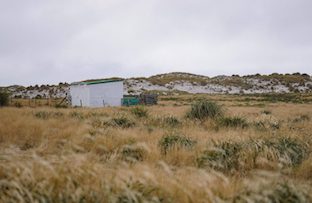Picture a land with endless opportunities to explore by foot. A landscape which invigorates your intrepid nature and propels you forward in search of discovery. In essence, the perfect terrain in which to indulge your love of walking and hiking. What if I told you such a place does exist? Let me introduce you to...
Walking in the Falkland Islands
Walking in the Falklands is a hugely rewarding experience. With few restrictions on where you can trek, the islands offer a multitude of routes - from an easy-going amble around a headland, to a heart-pumping hike up a mountainside. Below is just a taster of the amazing walks on offer in the Falklands, plus some tips for when you head there yourself!
Goose Green walk from Darwin
The historic settlement of Darwin sits on as isthmus in East Falkland, where two halves meet. The area played a significant role in the 1982 battle, a fact which is evident in the number of war memorials that dot the landscape.
Starting from the ideally located Darwin House, duck down to the waterfront where you'll have a tranquil view over Choiseul Sound and the birdlife that flock here.

Sunrise view from Darwin House
If you can pull yourself away from the view, head back towards the settlement and follow the road (the only road - you won't get lost!) up to the 2 Para Memorial. On the way up you'll pass a flock of curious sheep and an old corral used by gauchos in the 19th century. Once you meet the main road, turn right to visit the Royal Engineers memorial and if you keep walking (approx 5km from Darwin), the Argentine war cemetery.

Birds on platform in Darwin; 2 Para Memorial; corral; sheep
Turn left and you'll be heading towards Goose Green which was occupied by Argentine forces during the Falklands War. Looking out over the sound as you walk, you can see the shipwrecked Garland, as well as the Vicar of Bray closer towards Goose Green jetty. Goose Green is a charming coastal village where almost all of the houses have the same colour scheme. Here you can visit the community centre where locals were held hostage during the conflict. It's also home to what is rumoured to be (by the locals at least) the world's largest sheep shearing shed.

Bodie Creek suspension bridge; Goose Green sign; horse in front of shipwrecked garland; Goose Green
From Darwin, it's worth pushing on a little further to see the world's most southern suspension bridge at Bodie Creek. Built to transport sheep, it creates a strange juxtaposition between what once must have been an extravagant landmark and an agrarian background. Although, after being left to deteriorate over the years, it's currently not safe to cross. The walk to Bodie Creek is approx 7km one way.
Carcass Island
Carcass Island is often touted as being the most picturesque of the inhabited Falkland Islands, and it sure does know how to turn on the charm. You don't have to venture far from the residence to appreciate the stunning scenery either, but if you do you'll be rewarded for your efforts!

View from Carcass Island accommodation; Dyke Bay
Head south of the settlement while following the 4X4 track, or the coast, to Dyke Bay - one of my favourite beaches in the Falklands. You’ll pass Magellanic penguin burrows and may come across a colony of Gentoo penguins on your way. Stop to enjoy the peacefulness of this gorgeous beach, or continue along the perimeter of the island to Cave Point where you can enjoy the tranquil view over Byron Sound.
To continue south, weave your way through the tussock - being mindful of penguin burrows and avoiding the steep rocky cliff on this side of the island. Navigate up to ram paddock hill where you can add to the rock sculptures at the top.

Ram Paddock Hill; Magellanic Penguins
From here, you have a beautiful view over Needles Point and a chain small islands that were once used to test cannon range. Apparently, cannon balls are still found in the vicinity. Below ram paddock hill lies Leopard beach, where again you’ll find the two penguins species of the island. If you’re feeling adventurous and have plenty of time up your sleeve, you can carry on right around the island from here. Alternatively head back up to, and then past the settlement to Stanley Hill, where you’ll be rewarded with a view over much of the island.

View from Stanley Hill
Walking around Carcass is fairly straight forward if you follow the tracks and avoid the taller tussock plants which can be hard to pass through. The hill climbs aren’t strenuous and there are no off-limit areas.
Sea Lion Island
At only 7.8 km long and 2.3 km wide you can easily walk around Sea Lion Island in a day (with time to appreciate the bucolic landscape and its array of wildlife along the way)! Just make your own track as you go - as there is no farming on Sea Lion Island, there are no fences to clamber over or under. Not having any grazing animals also allows the island to have a unique flora, with some plants unique to this island of the Falklands.

Shed and tussock on Sea Lion Island
On your journey around the island, you’ll find waterfowl lingering by the ponds, Magellanic penguins peeking out from their burrows, Gentoos playing in the surf, and Rockhoppers perched on the jagged cliff faces. If you're lucky, you may even spot the odd Macaroni penguin playing hide and seek among its lookalike cousin the Rockhopper. There is an abundance of birdlife on this island due to its rodent-free status, and the landscape of pure white sand beaches on one side, and steep cliff faces on the other is simply breathtaking.
The main attraction on Sea Lion is undoubtedly the sea lions and elephant seals that congregate on the beaches and lay among the tussock laden dunes. You'll see their telltale tracks in the sand or hear their menacing guttural sound well before you lay eyes on the massive marine mammals.
Those wanting a shorter walk can simply head straight out in front of Sea Lion lodge and around the northeast point of the island - where you'll get a compact, yet impressively diverse introduction to the island - and its inhabitants.
Stanley to Gypsy Cove (and Cape Pembroke)
Starting in Stanley, wander down the main street past the Christ Church Cathedral and whalebone arch, while taking in the war memorials peppered along the waterfront. Make sure to stop and admire the inspiring local photography on public display before you reach the Jetty Visitor Centre.

Stanley Waterfront; Christ Church Cathedral framed by Whalebone Arch; Photo Wall
Gypsy Cove is an idyllic looking beach located just a 1.5hr walk from Stanley. To get there, follow airport road before taking a left turn to walk over Boxer Bridge, then follow the signs to Gypsy Cove. You'll pass Whalebone Cove on the way, where the shipwrecked Lady Elizabeth is an imposing sight just offshore.

Lady Elizabeth wreck
Once you arrive at Gypsy Cove there is a short signposted walk to several viewing platforms. From here you have a view over Yorke Bay - an expansive beach that is currently off-limits due to the threat of undiscovered landmines left after the Falklands war. September to April, you'll find Megallanic Penguins making their homes in the soft earth that surrounds the beaches. Several other bird species such as rock cormorants, black-crowned night herons, oystercatchers and steamer ducks are also found here.

Gypsy Cove; Walk to Gypsy Cove; Magellanic Penguins
From Gypsy Cove, you can either walk back to Stanley or head east along a dusty road to the Cape Pembroke. After passing Yorke Bay, take the opportunity to pause and appreciate the serenity on a pristine private beach. You may even see dolphins swimming in the clear turquoise waters. Use the lighthouse to guide your way to the Cape where a memorial to the Atlantic Conveyor sits - a tribute to those who lost their lives when the ship sank during the war.

Lighthouse; Atlantic Conveyor Memorial; View on walk to Lighthouse
To return to Stanley, head back towards the airport and follow airport road. You'll pass Hookers Point and the HMS Glamorgan memorial on the way.
Tips for Walking in the Falklands
Always follow the country code so as not to disturb the wildlife or their habitat.
You'll need sturdy hiking boots to navigate the rugged terrain of the Falklands. Opt for waterproof if you can!
Take layers of clothing and be ready to experience several seasons in one day.
Always take water and food in your backpack - you won't find any amenities on the way!
Tell someone your plans for the day before setting out. You'll struggle to get phone reception outside of Stanley, so make sure someone knows how to find you.
You can download information about the islands, including maps and a copy of the country code, on the Falklands Tourism website.
And finally, enjoy every minute! Wherever you choose to walk in the Falklands, you'll be left with incredible memories of your time in this stunning corner of the world.
*Reproduced with permission from blogilicious.com- the world’s largest search and discovery platform for travel blogs
Related
Comments
Comments are disabled for this post.

.png)




